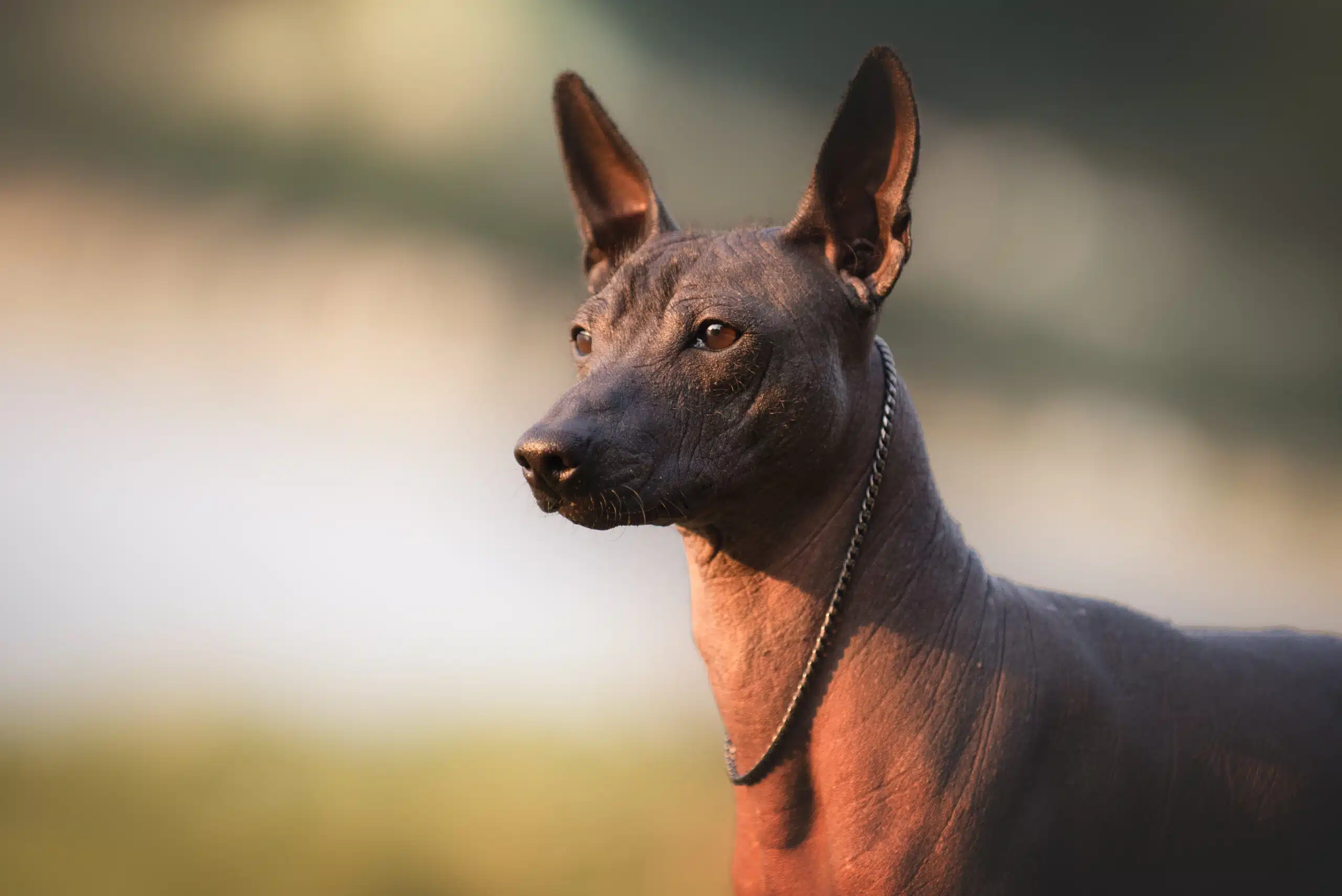Xoloitzcuintli

The Xolo, often referred to as the first dog of America, has been around for centuries – possibly even millennia! In fact, pre-Columbian pottery and Spanish conquistador reports showcase images that provide evidence. Beloved due to its healing properties and warmth against ailments such as asthma or rheumatic pain, this breed was also known for protecting people from evil spirits and intruders. Its history is filled with miraculous occurrences that have made it renowned throughout time.
The Xoloitzcuintli breed was initially valued as a hunting aid, but with the rise of the Aztec empire it became more significant due to its association with “Xolotl”, the god of fire. It is easy to see why this particular breed gained its name when we consider that the “itzcuintli” was what they called dogs in those days. The Aztecs (as many people today do) believed that these canines had exceptional healing powers which could help cure sickness and disease. The majestic and aptly named Xoloitzcuintli, or “show-low” for short, is as unique and inquisitive as its name suggests.
This breed of dog loves nothing more than to spend quality time with their family; however, they still require ample exercise, grooming sessions and attention nonetheless. Despite the difficult pronunciation – it’s pronounced “show-low-eetz-kweent-lee” – this Mexican Hairless will certainly steal your heart in no time! The Xolo used to be a spiritual messenger of the afterlife, but nowadays is renowned for its kind and compassionate nature. This breed forms tight attachments with those that it loves, often displaying loyalty and affection through physical closeness.
If you’re seeking a loyal animal companion, consider the distinctive Xoloitzcuintli, or Xolo. This breed is recognizable by its smooth head, wrinkled brows, thin-skinned, upright ears, and satiny thick skin. Typically, Xolos have dark coats, often black or grayish-black, with possible white spots and bronze or liver markings, though they are generally uniform in color.
The Xolo requires moderate daily exercise, such as 20 to 30 minutes of walking or play in a secure area. They excel in dog sports like agility, obedience, and rally. Due to their hairless nature, it’s crucial to protect Xolos from prolonged sun exposure by using dog-safe sunscreen or scheduling activities in the early morning or late evening.
Xolos thrive on companionship and should live indoors due to their sensitive skin. They need comfortable bedding to support their sleek build and keep warm, especially in winter. In extreme temperatures, protective clothing or climate control may be necessary. Regular bathing and the application of oils or moisturizers will keep their skin healthy. Consult your breeder for any specific grooming recommendations.
Introduction to the Xoloitzcuintli: A Breed of Ancient Distinction
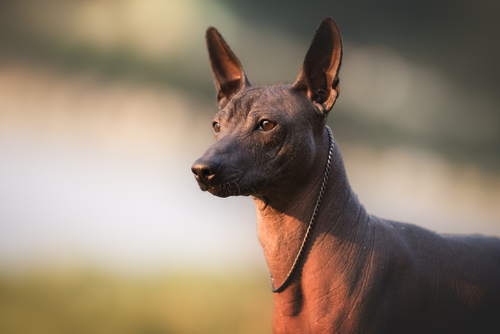
The Mexican hairless dog, often simply called the “Xolo,” is more than just a dog breed; it represents a rich tapestry of cultural history, wrapped in a distinct physical form characterized by its unique hairlessness. Known for its hairlessness, the Xolo dog holds a special place in Mexican heritage and stands out due to its striking appearance, historical importance to the Aztecs, and storied past.
This breed, with its deep roots and unique characteristics, offers a fascinating glimpse into ancient traditions and modern canine appreciation. Among unusual dogs, the Xoloitzcuintle occupies a distinct place, revered not just for its ancient heritage but also for its cultural significance, marking it as a truly unique member of the canine world.
Key Points
- Physical Characteristics: The Xoloitzcuintli is characterized by its lack of fur, displaying a smooth skin that can appear in shades like black, gray-black, slate, and bronze. The breed comes in three sizes: toy, miniature, and standard, which range from 10 to 30 inches in height.
- Temperament: Known for its intelligence and loyalty, the Xolo forms close bonds with its family. It is protective yet not aggressive, making it an excellent watchdog and a compassionate companion.
- Historical Role: Revered by ancient civilizations such as the Aztecs, Mayans, and Toltecs, Xolos were considered sacred animals believed to have healing properties and spiritual significance, often associated with the journey of the soul in the afterlife.
- Cultural Significance: As one of the oldest dog breeds, the Xoloitzcuintli has been a part of Mexican culture for over 3,000 years and is recognized today as the national dog of Mexico.
- Modern Recognition: The Xolo’s unique traits have not only made it a subject of interest in cultural studies but also gained it recognition in various kennel clubs around the world, enhancing its profile among dog enthusiasts and pet owners alike.
The Xoloitzcuintli is not merely a pet but a living piece of history. Its presence in a home is not only about companionship but also about embracing a legacy that dates back millennia. As we explore further into the grooming needs, behavioral traits, and the best living conditions for this breed, the distinctive nature of the Xolo becomes increasingly evident, making it a prized choice for those who appreciate both the aesthetic and historical richness of their canine friends.
Breed Overview of the Mexican Hairless Dog (Xoloitzcuintli)

Understanding the Xoloitzcuintli’s breed characteristics thoroughly can help potential owners and enthusiasts appreciate why this breed might be the right choice for their family. The Xoloitzcuintli is considered a healthy breed, thanks to its genetic diversity and the fact that it has not been overbred.
This has allowed for natural development and a hardy constitution, originating from its ancient jungle roots. It’s crucial to choose a reputable breeder who screens for health problems to maintain this breed’s health. This section provides a detailed overview of the Xolo’s physical attributes, health considerations, and typical lifespan, offering insight into the care and commitment involved in raising a Xolo.
Physical Characteristics
- Size Variations: The Xoloitzcuintli comes in three size categories: toy, miniature, and standard, which allows for flexibility depending on living arrangements and personal preference. Toys typically stand about 10-14 inches at the shoulder, miniatures range from 14-18 inches, and standards stand about 18-30 inches tall.
- Dog’s Weight Range: Corresponding to their size, the weight of a Xolo can vary significantly. Toy Xolos weigh around 10-15 pounds, miniatures from 15-30 pounds, and standards can weigh between 30-55 pounds.
- Physical Build: The breed is characterized by a sleek body, a pronounced chest, and a level back, contributing to its graceful, statuesque appearance. The limbs are proportionately long and slender, adding to the elegance of their stance.
- Skin and Color: One of the most distinctive features of the Xoloitzcuintli is its hairless skin, which feels smooth to the touch and can be seen in a variety of colors, including charcoal, black, liver, mahogany, and bronze. Some Xolos may have a light pattern of spots or freckles. There is also a coated variety that has a short, sleek coat that sheds minimally.
Health and Lifespan
- General Health: Xolos are generally healthy dogs, but like all breeds, they are prone to certain health conditions. Their hairlessness makes them susceptible to skin issues such as acne, blackheads, and sunburn.
- Dental Health: Dental health is a significant concern for the Xolo due to their genetic predisposition towards poor dental conditions. Regular dental check-ups and cleanings are crucial to prevent tooth decay and loss.
- Temperature Sensitivity: Their lack of fur makes them particularly sensitive to temperature extremes. Owners need to ensure that Xolos are protected from prolonged exposure to direct sunlight and cold conditions.
- Lifespan: With proper care, the Xoloitzcuintli can enjoy a long life. The breed typically lives between 13 and 18 years, which is a testament to their resilience and the importance of diligent care and regular veterinary check-ups.
Temperament
- Behavioral Traits: Xolos are known for their loyalty and intelligence. They are naturally protective of their family, which can make them excellent guard dogs. Despite their protective nature, they are not typically aggressive.
- Compatibility with Families: Xolos are affectionate with their family members and can be excellent companions for children, provided they are socialized early. Their gentle and patient demeanor makes them suitable for families with respectful children.
- Interaction with Other Pets: While Xolos can coexist peacefully with other dogs and pets, early socialization is key to fostering harmonious relationships. Their calm yet alert nature allows them to adapt well to various household dynamics.
The Xoloitzcuintli’s unique physical and behavioral characteristics make it a fascinating breed. Whether you are attracted to their elegant appearance, intrigued by their ancient heritage, or looking for a loyal and intelligent companion, understanding these aspects of the breed is crucial. Potential owners should consider all these factors to ensure they can provide a nurturing and suitable home that caters to the Xolo’s specific needs.
Historical Significance of the Xoloitzcuintli Dog Breed
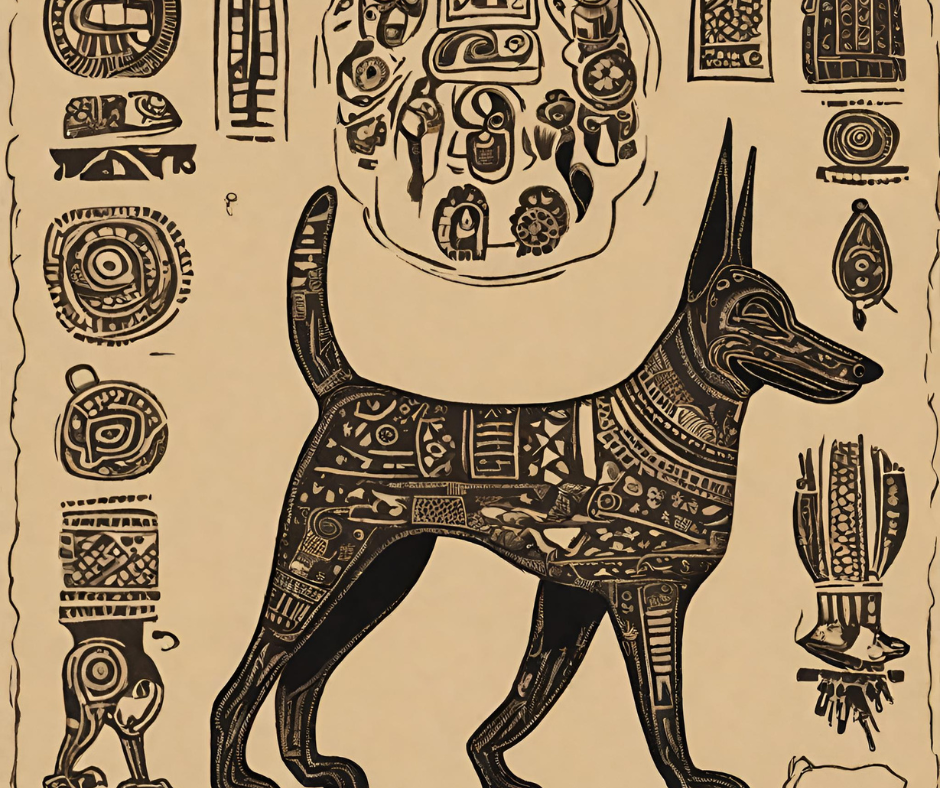
Xolo dogs, are not just a breed; they are an historical emblem that traces its origins back over 3,000 years, intertwining deeply with the cultural fabric of ancient Mesoamerican civilizations. Known also as Mexican hairless dogs, these animals hold a significant place in history, serving not only as companions but also playing symbolic roles across different cultures, and their resurgence as a modern cultural icon in Mexico.
In ancient times, Xoloitzcuintlis were domesticated and bred as dog meat and a food source by the Aztecs, alongside turkey meat. Sixteenth-century Spanish accounts describe large numbers of dogs being served at banquets, often alongside turkey, highlighting the consumption of dog meat in their diet. The Aztecs were said to have consumed few domesticated animals, with deer being the primary meat source. This historical aspect underscores the breed’s importance beyond companionship, reflecting its role in the survival and cultural practices of ancient civilizations.
In recent years, the Xoloitzcuintli has also seen a resurgence in recognition by the American Kennel Club (AKC), marking a significant milestone in the breed’s history. After being previously dropped from the AKC stud book, concerted efforts by breed enthusiasts led to the Xoloitzcuintli’s readmission and its achievement of AKC champion status. This recognition not only highlights the breed’s historical significance but also underscores its modern-day relevance and continued legacy as a cultural and canine icon.
Ancient Roots and Cultural Importance
- Origins in Ancient Mesoamerica: The Xoloitzcuintli is one of the most ancient dog breeds, believed to have originated in ancient Mexico. Archaeological evidence, including depictions on pottery and burial artifacts from the Aztec, Maya, and Toltec cultures, highlights the breed’s presence and significance. These cultures revered the Xolo not only for its physical attributes but also for its spiritual significance.
- Spiritual and Symbolic Roles: In ancient times, the Xolo was more than a companion animal; it was imbued with significant spiritual importance. The Aztecs believed that the Xolo possessed healing properties and could ward off evil spirits and sickness. More profoundly, they were regarded as sacred beings that guided the souls of the dead to the underworld. This connection with the afterlife made Xolos integral in funeral rites and ceremonies, symbolizing the link between life and death.
The Xolo in Mythology and Art
- Depictions in Art and Artifacts: Xolos frequently appeared in the art and artifacts of ancient civilizations. They were depicted in a variety of media, from terracotta figurines to wall murals, often portrayed lying at the feet of their owners or as part of religious and ceremonial scenes, emphasizing their role as both protectors and companions.
- Mythological Significance: The breed’s name itself is derived from the god Xolotl, the Aztec deity of lightning and death. Xolotl was believed to have created the Xolo from a sliver of the Bone of Life from which all humans were made. This myth underscores the believed spiritual connection between Xolos and humans, as the dogs were thought to be necessary companions in life and invaluable guides in death.
Modern Cultural Resurgence
- National Symbol of Mexico: In modern times, the Xoloitzcuintli has seen a resurgence as a symbol of national pride in Mexico. Officially recognized as part of the country’s cultural heritage, the Xolo is celebrated in contemporary Mexican culture, art, and media. It appears in everything from paintings and sculptures to films and literature, often used to evoke a sense of Mexican identity and heritage.
- Preservation Efforts: Recognizing the breed’s historical and cultural significance, several initiatives have been launched to preserve and protect the Xoloitzcuintli. Breed enthusiasts and cultural historians alike have championed efforts to maintain the breed’s purity and promote its unique qualities. These efforts include breeding programs, national and international dog shows, and educational campaigns about the breed’s history and care.
Through centuries of history, the Xoloitzcuintli has transcended its role as merely a pet or companion dog to become a profound cultural symbol, embodying the ancient legacies and modern pride of Mexico. This deep historical significance enriches the appeal of the Xolo, making it not only a unique pet but also a living piece of history and culture.
Grooming and Care for the Xoloitzcuintli
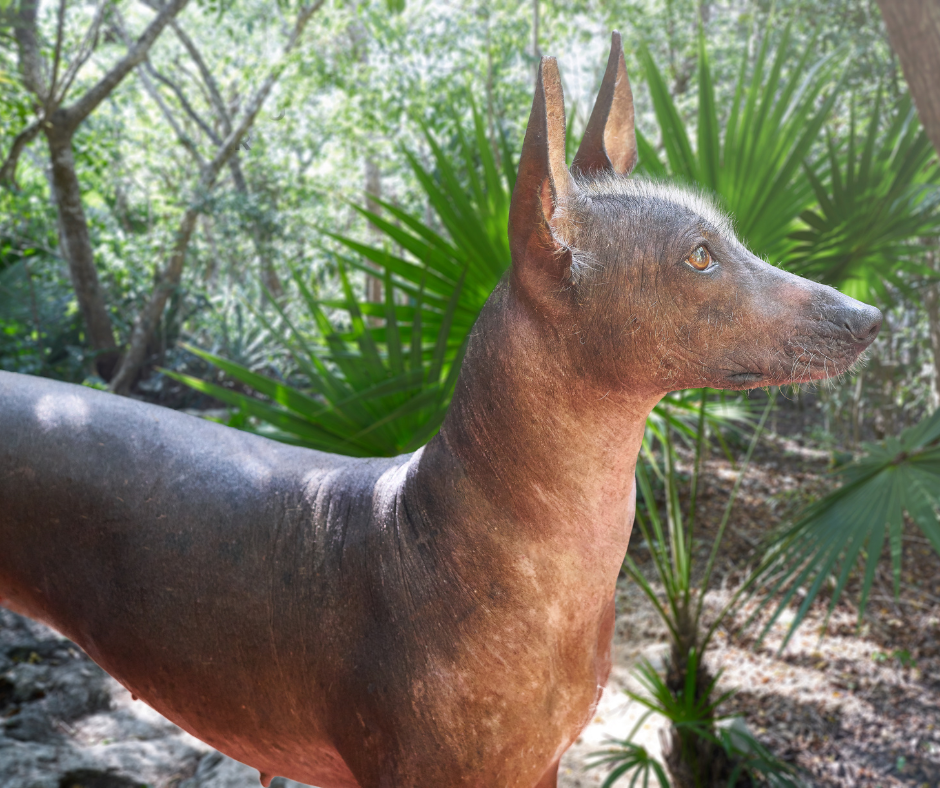
Grooming and caring for a Xoloitzcuintli, particularly the hairless variety, involves specialized attention to ensure the dog’s skin remains healthy and the overall well-being of the breed is maintained. Similar to other dog breeds with unique physical types, Xolos require regular bathing, grooming, and skin care, but with unique considerations to avoid over-bathing and over-lotioning, which can lead to skin problems.
This includes the importance of removing dead skin cells through regular wiping and moisturizing to maintain the health and appearance of the Xolo’s skin. This section will cover comprehensive grooming practices, recommended skincare products, and general care tips that are essential for any Xolo owner.
Skin Care Essentials
- Moisturizing: The Xolo’s skin can be prone to dryness due to its hairlessness. Regular moisturizing is crucial to prevent irritation and cracking. Pet-safe moisturizers or natural oils like coconut or almond oil are recommended, which should be gently massaged into the skin after bathing.
- Sun Protection: Due to their lack of fur, Xolos are highly susceptible to sunburn. Applying a pet-safe sunscreen before going outdoors is essential, especially during peak sunlight hours. Sunscreen should be reapplied according to the product instructions, particularly if the dog is active outdoors for extended periods.
- Bathing: Xolos should be bathed every two to three weeks with a gentle, hypoallergenic shampoo to keep their skin clean without stripping essential oils. Care should be taken to thoroughly rinse the skin to prevent residue build-up, which can cause irritation.
Special Grooming Considerations
- Exfoliation: To prevent pore clogging and blackheads, which Xolos are prone to, gentle exfoliation can be beneficial. This can be done during the bathing process using a soft brush or a special exfoliating glove. However, it’s important to exfoliate gently to avoid damaging the skin.
- Eye and Ear Care: Regular checks should be made to ensure that there is no buildup of dirt in the eyes and ears. Clean these areas gently with a damp cloth and a vet-recommended solution to prevent infections.
- Nail Care: Xolo’s nails should be trimmed regularly to prevent overgrowth, which can lead to discomfort and mobility issues. This is particularly important as overgrown nails can scratch their sensitive skin.
General Health and Comfort
- Temperature Regulation: Without natural fur, Xolos need help regulating their body temperature. In cold weather, they may require sweaters or coats, and in very warm weather, access to shade and plenty of fresh water is necessary to prevent overheating.
- Sleeping Arrangements: Providing a comfortable sleeping area is essential. Xolos benefit from soft bedding to prevent pressure sores and keep them warm. Elevated beds can also help to keep them off cold or overly warm floors.
- Diet and Nutrition: A balanced diet is crucial for maintaining healthy skin and overall health. Foods rich in omega fatty acids can help keep the Xolo’s skin supple. Consultation with a vet can provide guidance on the best food choices and supplements to support their unique needs.
Caring for a Xoloitzcuintli requires understanding and accommodating their specific needs due to their hairlessness and sensitive skin. Proper grooming, attentive care, and regular veterinary check-ups will ensure that these unique and historical dogs lead a healthy, comfortable life. The effort put into their care is rewarded by the deep bond formed with this affectionate, loyal companion.
Training and Behavior of the Xoloitzcuintli

Training a Xoloitzcuintli involves understanding its unique temperament and learning styles. Known for their intelligence and sensitivity, Xolos can be both a joy and a challenge to train. This section will explore effective training techniques, common behavioral traits, and tips for managing a well-behaved and happy Xolo.
Understanding Xolo Temperament
- Intelligence and Sensitivity: Xolos are highly intelligent and sensitive dogs, which can make them quick learners, but also means they are highly responsive to their owner’s emotions and tone of voice. Training should always be conducted in a calm, positive manner to avoid causing anxiety or fear.
- Loyalty and Protective Nature: Xolos are known for their strong loyalty to their family, which can manifest as protective behavior. While this makes them excellent watchdogs, it is important to manage this trait through socialization and training to ensure they do not become overly protective or aggressive.
Effective Training Techniques
- Positive Reinforcement: Xolos respond well to positive reinforcement techniques such as treats, praise, and play. This method reinforces good behavior without the need for harsh discipline, which can be detrimental to the relationship with a sensitive breed like the Xolo.
- Consistency is Key: Regular, consistent training sessions help reinforce learning and behavior. Short, frequent training sessions are recommended to keep the Xolo engaged and prevent them from becoming bored or distracted.
- Early Socialization: Socializing a Xolo from a young age is crucial. Exposure to different people, animals, environments, and situations can help prevent the development of fearful or aggressive behaviors. This is particularly important given their protective nature.
Common Behavioral Traits
- Reserved With Strangers: Xolos can be aloof or reserved around strangers. This trait can be managed through continued socialization and training to help the dog become more comfortable around new people.
- Tendency to Bark: Xolos can be vocal, often using their bark to alert their owners to perceived threats. Training to obey commands to stop barking can be very useful in managing this behavior.
- High Energy Levels: Despite their often calm demeanor, Xolos can have bursts of high energy. Providing adequate physical and mental stimulation is essential to keep them well-balanced and prevent behavioral issues for this active dog.
Behavioral Management Tips
- Routine: Establishing a routine can help manage a Xolo’s behavior. Regular feeding times, walks, and bedtime help create a structured environment that can make a Xolo feel secure.
- Exercise: Adequate exercise is important for maintaining the Xolo’s physical and mental health. Activities should be varied and can include walks, play sessions, and other forms of exercise to keep them engaged.
- Mental Stimulation: Due to their intelligence, Xolos need mental challenges to keep them from becoming bored. Puzzle toys, training challenges, and games can provide necessary mental stimulation.
Training a Xoloitzcuintli offers an opportunity to bond deeply with these unique and historically rich dogs. Their intelligence, combined with their loyal and protective nature, makes them not just pets, but true companions. With the right approach, training a Xolo can be a rewarding experience that enhances their inherent qualities while ensuring they are adaptable and well-behaved members of any family.
Ideal Living Conditions for the Xoloitzcuintli

Creating the right environment for a Xoloitzcuintli is crucial to their well-being. Given their unique physical characteristics, particularly their hairlessness, Xolos have specific needs in terms of housing, climate control, and daily routines. This section will detail the optimal living conditions that cater to the health and happiness of a Xolo.
Housing and Space Requirements
- Indoor Living: Xolos are predominantly indoor dogs due to their lack of fur, which makes them susceptible to weather extremes. A temperate indoor environment is essential to keep them comfortable. While they do not require a large living space, they should have a designated area where they feel secure and can retreat to when needed.
- Bedding: Due to their hairless skin, Xolos can develop sores or discomfort from lying on hard surfaces. Soft, cushioned bedding is vital to provide comfort and support, and it should be placed in a warm area of the home, away from drafts.
Climate Control
- Temperature Sensitivity: Xolos are particularly sensitive to cold and heat. In colder climates, they may require sweaters or even heated beds to maintain a comfortable body temperature. During hot weather, air conditioning or fans can help prevent overheating, and shade should always be available outdoors.
- Skin Care in Various Weathers: Protecting a Xolo’s skin is important year-round. In winter, a moisturizer can prevent dry, cracked skin, while sunscreen is necessary in summer to protect against sunburn.
Exercise and Stimulation
- Exercise Needs: Despite their calm demeanor, Xolos need regular exercise to maintain their health. Daily walks are important, not only for physical exercise but also for mental stimulation. They also enjoy play sessions that can include interactive toys and games.
- Mental Engagement: Intelligent and curious, Xolos require mental stimulation to prevent boredom, which can lead to destructive behaviors. Training sessions, puzzle toys, and safe chew toys can keep their minds active.
Interaction and Social Needs
- Family Interaction: Xolos thrive on interaction with their family and can become very attached to their human companions. They should be included in family activities and not left isolated for long periods.
- Socialization: Continued socialization is important for Xolos. Regular, controlled interactions with other dogs and people help them maintain their social skills and manage their natural reserve around strangers.
Safety Measures
- Secure Environment: A secure living environment is essential for a Xolo. Because they can be escape artists, fences should be secure, and indoor spaces should be puppy-proofed to prevent accidents.
- Regular Health Checks: Regular veterinary visits are important to monitor the health of a Xolo, particularly skin, dental, and overall physical health. Preventive care is key to addressing potential health issues early.
Creating an ideal living environment for a Xoloitzcuintli involves thoughtful consideration of their physical, mental, and emotional needs. By providing a warm and secure home, regular exercise, and plenty of affection, owners can ensure their Xolo not only survives but thrives as a cherished member of the family.
Health and Nutrition of the Xoloitzcuintli: A Healthy Breed

Proper health management and a nutritious diet are paramount for maintaining the well-being of a Xoloitzcuintli. This section outlines the health considerations specific to the breed and provides guidelines for an optimal diet that supports their unique physiological needs. Xoloitzcuintli puppies should be fed a diet that caters to their growth and development needs, highlighting the importance of puppy-specific food until they reach 1 year of age.
Health Considerations
- Skin Health: The Xolo’s hairless skin requires special attention. Regular checks for irritations, acne, and signs of sunburn are necessary. Their skin should be cleaned and moisturized with products specifically formulated for sensitive, hairless pets to prevent dryness and cracking.
- Dental Health: Xolos are prone to dental issues due to their genetic makeup, which can lead to early tooth loss. Regular dental check-ups and cleanings, along with daily brushing at home, are crucial for maintaining good oral hygiene.
- Temperature Sensitivity: Due to their lack of a natural fur coat, Xolos are particularly vulnerable to extreme temperatures. Owners should take precautions to ensure their environment is neither too hot nor too cold.
- Common Health Problems: Like many purebred dogs, Xolos can be susceptible to certain hereditary conditions, including joint issues like hip dysplasia, and eye problems such as glaucoma. Regular visits to the vet for check-ups can help catch and manage these issues early.
Nutrition
- Dietary Requirements: Xolos require a well-balanced diet rich in high-quality proteins and fats to support their skin health and overall energy needs. Foods that are high in Omega-3 and Omega-6 fatty acids can help maintain their skin’s health and appearance.
- Feeding Schedule: Consistent feeding times help regulate a Xolo’s digestion and energy levels. Adult Xolos typically do well with two meals per day, while puppies may require more frequent feeding.
- Special Dietary Considerations: Due to their sensitive skin and potential for allergies, Xolos may benefit from grain-free or limited-ingredient diets. Always consult with a veterinarian to tailor the diet to your dog’s specific health needs, including any food sensitivities.
Breeder and Adoption Information
Choosing to bring a Xoloitzcuintli into your home is a significant decision that requires careful consideration of where to obtain one. This section provides guidance on selecting reputable breeders and adopting from rescues or shelters. Prospective owners are also recommended to consult with a breed club for guidance on finding reputable breeders or adoption options. Breed clubs play a crucial role in providing information on the breed’s care, standards, physical characteristics, health issues, personality, temperament, and training.
Choosing a Reputable Breeder Recognized by the American Kennel Club
- Health Screenings: Ensure that the breeder provides health clearances for the puppies and their parents, proving they have been tested for common genetic diseases and are considered healthy for breeding.
- Transparency: Good breeders will welcome questions, allow visits to see where the dogs are raised, and show genuine interest in where their puppies are placed.
- Breed Knowledge: A reputable breeder should be knowledgeable about the Xoloitzcuintli breed and committed to maintaining the breed’s health and standards. They should provide guidance on caring for your new pet.
Adoption
- Rescue Organizations: There are several rescue organizations specifically dedicated to the Xoloitzcuintli breed. These organizations often have dogs that need homes and can provide background information on their temperament and health.
- Shelter Considerations: When adopting from a shelter, information about the dog’s background may be limited. Patience and training may be necessary to integrate a rescue Xolo into your home, especially if the dog has been previously mistreated or neglected.
Dog Breeds Similar to the Xoloitzcuintli
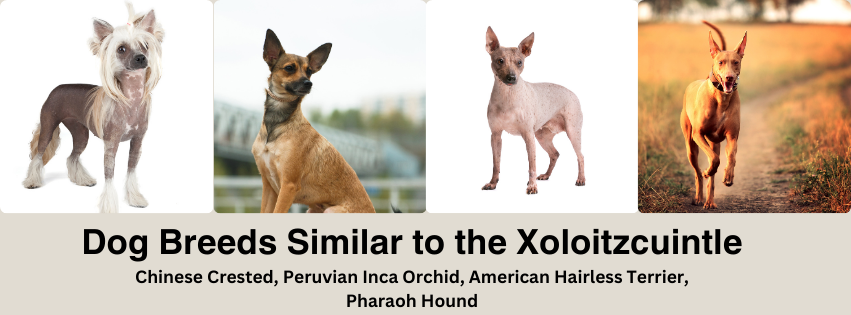
The Xoloitzcuintli, often referred to simply as the “Xolo,” is a unique breed known for its distinct appearance, primarily characterized by its hairlessness and elegant stature. While the Xolo is one of a kind in many ways, several other breeds share some of its traits and historical significance. Here are a few breeds similar to the Xolo:
- Chinese Crested: This breed is perhaps the most similar to the Xolo in terms of its most defining feature: hairlessness. The Chinese Crested comes in two varieties, hairless and powderpuff, the former displaying a mostly hairless body with hair only on the head, tail, and feet. Like the Xolo, they require special skincare to protect their exposed skin.
- Peruvian Inca Orchid (PIO): Another hairless breed, the Peruvian Inca Orchid shares a similar ancient heritage with the Xolo. Originating in Peru, this breed was also kept as a pet in ancient times, serving both as a companion and a bedwarmer. The PIO ranges in size from small to large and has a very similar skin texture to the Xolo.
- American Hairless Terrier: This breed is a relatively new addition to the group of hairless dogs but shares the characteristic lack of fur. Developed from the Rat Terrier, the American Hairless Terrier exhibits a friendly and energetic demeanor. Its skin care needs are akin to those of the Xolo, requiring protection from the sun and elements.
- Pharaoh Hound: While not hairless, the Pharaoh Hound shares the sleek body and elegant lines of the Xolo. This breed is known for its rich history, dating back to ancient Egypt. The Pharaoh Hound is highly active and intelligent, traits that it shares with the Xolo, making it a great companion for families who enjoy active lifestyles.
These breeds, while each possessing unique qualities, share commonalities with the Xoloitzcuintli, such as distinct appearances and special care requirements. Whether hairless or minimally coated, they all stand out due to their rich histories and distinctive looks.
Conclusion
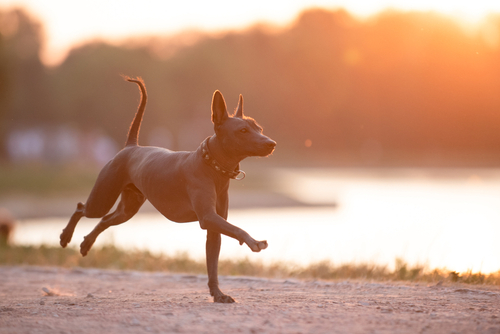
Owning a Xoloitzcuintli offers a unique opportunity to care for a breed with a rich cultural heritage and distinctive needs. Whether through a breeder or adoption, bringing a Xolo into your home requires a commitment to providing a loving environment, proper care, and regular medical attention. With the right preparation and understanding, a Xolo can make a loving, loyal, and fascinating addition to any family, enriching lives with its ancient legacy and charismatic presence.
- Group AKC Non Sporting
- Origin Mexico
- Size Small, Medium
- Weight 10 to 50 pounds
- Coat Length Short
- Coat Type Hairless, Smooth
- Colors Black,Brindle,Brown,Gray,White
- Other Names Mexican Hairless, Xoloitzcuintli, Xoloitzcuintle, Xoloitzquintle, Xoloescuincle, Xolo, Xolito
- Temperament Alert,Calm,Cheerful,Companionable,Loyal,Protective


